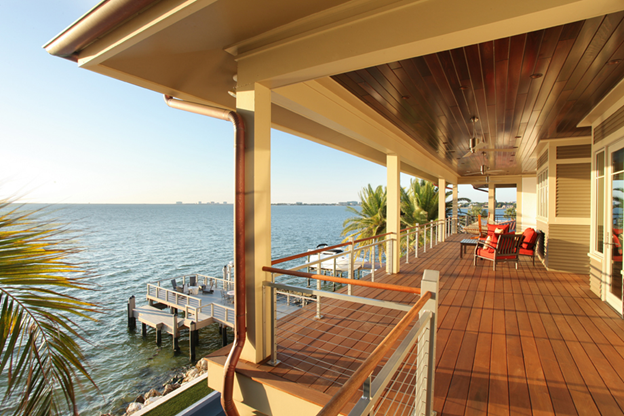Ipe decking, made from the tropical hardwood known as Brazilian Walnut, and Pressure-Treated (PT) lumber, which is typically pine that has been chemically treated to resist rot, decay, and termites, have distinct differences and advantages. Here’s a comparative look at the advantages of Ipe decking:
Durability and Longevity
-
Ipe:
One of the most durable hardwoods available, Ipe is incredibly resistant to rot, decay, and insect infestation. It can last over 40 years if maintained properly, even without chemical treatments. For its value, Ipe is remarkably more affordable than other hardwoods
-
PT Lumber:
While resistant to rot and pests due to its chemical treatment, PT lumber typically lasts between 10 to 15 years, depending on environmental conditions and maintenance. PT lumber is also prone to warping requiring replacements.
Aesthetics and Maintenance
-
Ipe:
Offers a rich, natural look with deep color variations that can range from reddish-brown to dark brown. It can be left to weather naturally to a silver-gray or oiled to preserve its original color. Ipe demands less maintenance than PT lumber, except when preserving its color is a priority.
-
PT Lumber:
Has a more uniform appearance but can be painted or stained to match any desired color. It requires regular maintenance, including staining or sealing every couple of years to maintain its appearance and durability.
Environmental Impact
-
Ipe:
Harvesting Ipe wood can have a significant environmental impact due to deforestation concerns in South America. However, sustainably sourced Ipe, certified by the Forest Stewardship Council (FSC), is available and minimizes environmental impact. Furthermore, Ipe imported into the US must comply with the Lacey Act requirements.
-
PT Lumber:
The chemicals used for treating PT lumber can be harmful to the environment and human health. However, newer, less toxic alternatives to the traditional arsenic-based treatments are now used, making PT lumber safer than it once was.
Cost
-
Ipe:
Generally more expensive than PT lumber due to its durability and aesthetic qualities. The initial investment may be higher, but its longevity makes it more cost-effective over time. Once installed it will last decades.
-
PT Lumber
Less expensive upfront and widely available. While it may require more maintenance and replacement over time, it’s a more budget-friendly option for those looking to minimize initial costs.
Installation and Workability
-
Ipe
Its extreme hardness makes cutting and fastening more challenging, often requiring DIYers to purchase carbide saw blades and bits. This can increase the cost of installation. However, when employing a pro they possess all the necessary tools.
-
PT Lumber
Easier to cut, nail, or screw without the need for specialized equipment, making it a more DIY-friendly option.
Choosing between Ipe decking and PT lumber depends on your priorities regarding durability, aesthetics, environmental impact, cost, and ease of installation. Ipe offers a premium, long-lasting option with unique beauty, while PT lumber is a more cost-effective, easily workable choice suitable for a wide range of projects. Ipe will enhance the value of your home at the time of



